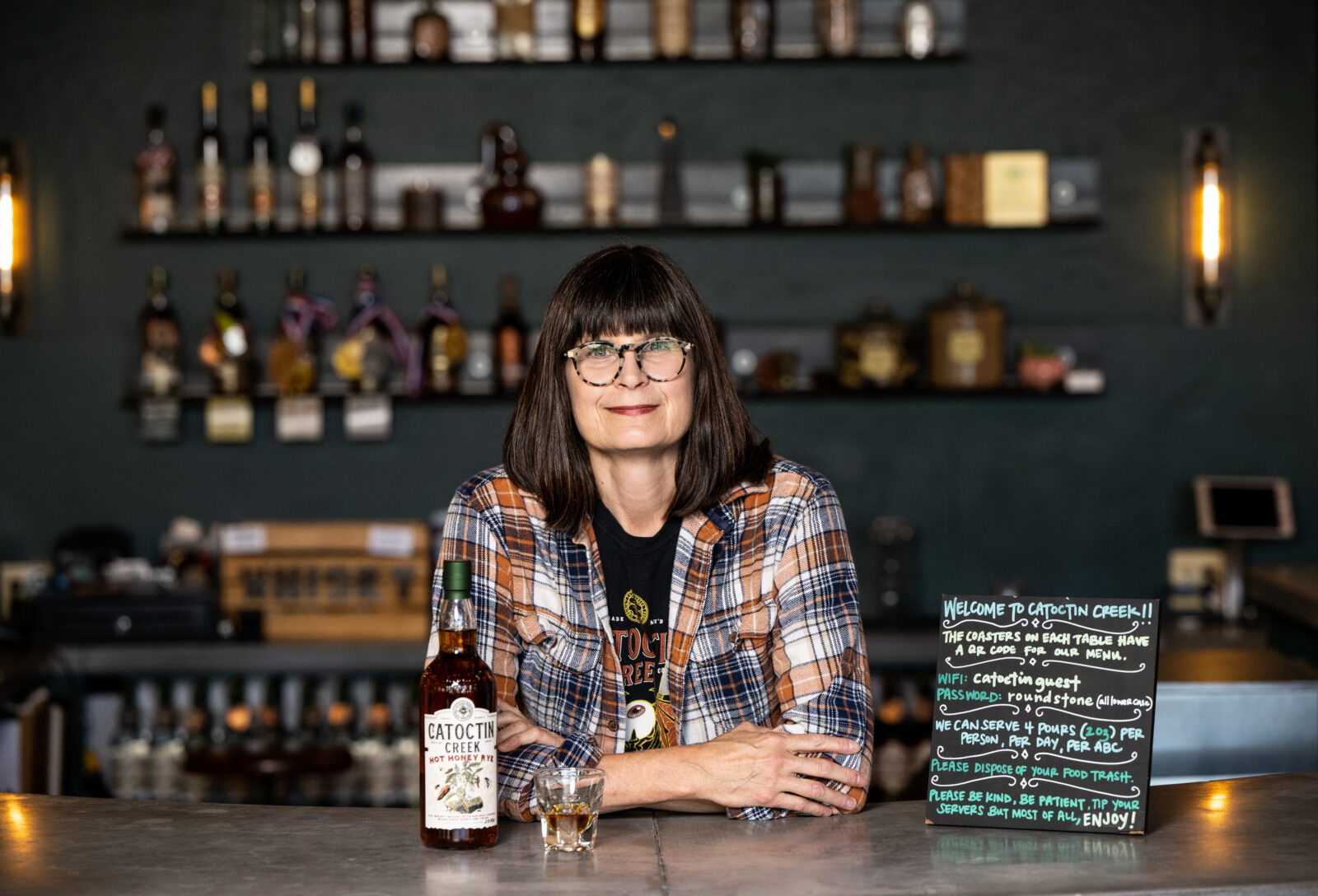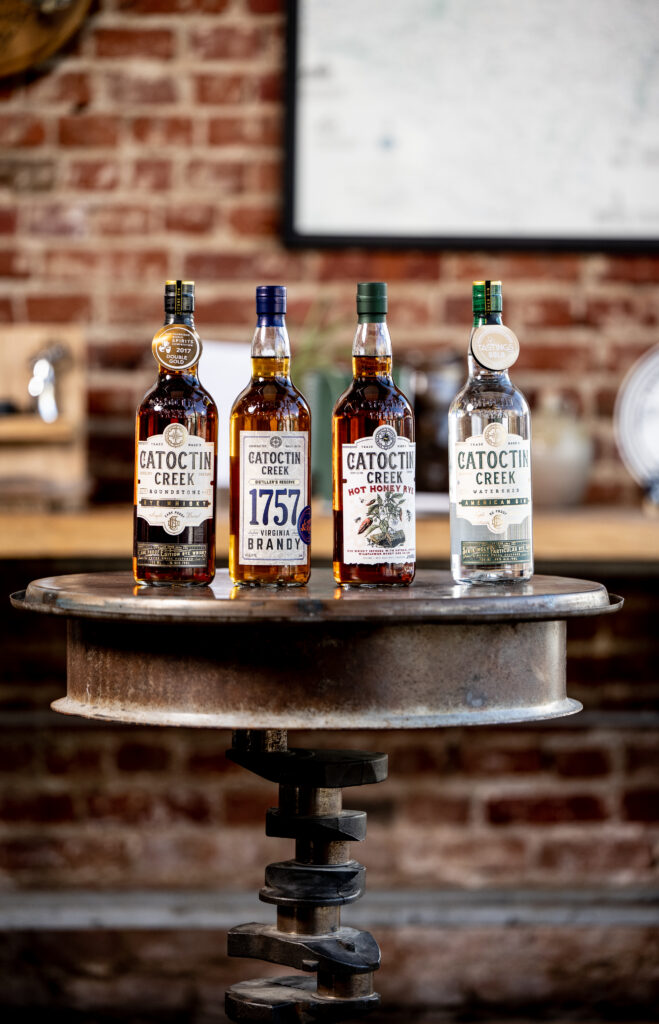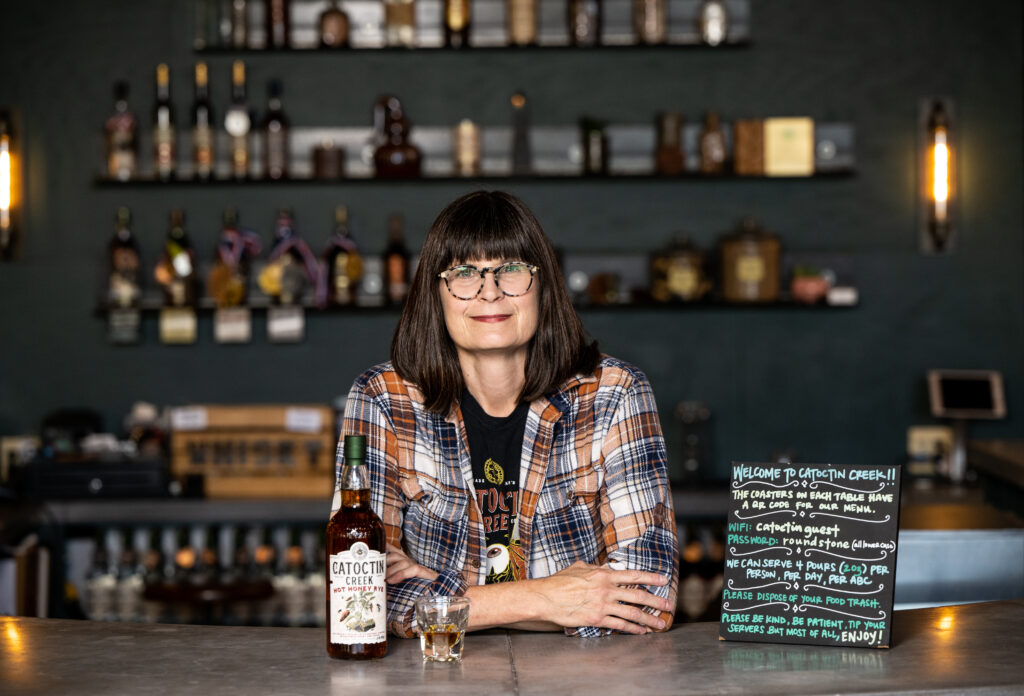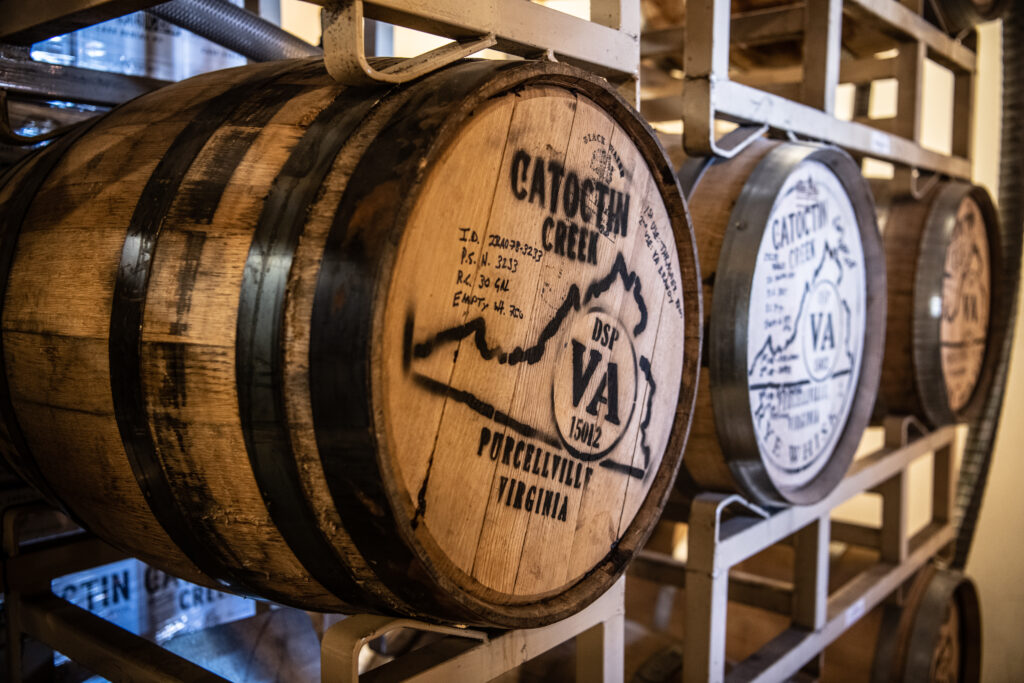All About Rye at Catoctin Creek

Written by Carlo Massimo | Photos by Michael Butcher
The aroma of fermenting mash is overpowering, sweet with yeast and sharp as green timber, but Becky Harris, founder of Catoctin Creek Distilling Company in Purcellville, no longer notices it. The barstool she sits on in the Catoctin Creek tasting room looks out on the distillery floor: two pot stills, steel fermentation tanks, a conveyor belt-fed bottling machine, and the quiet trickle of unaged rye whiskey. This is Catoctin Creek’s specialty, and although the company makes brandy, eau de vie, and gin, Catoctin Creek and rye are almost synonyms.
It’s a historical passion as well as a matter of taste for Harris, who founded Catoctin Creek with her husband Scott in 2009.
“If you look back at the 1600s and 1700s, rye was the only spirit distilled on the Eastern Seaboard,” she says. “Virginia’s main crop was tobacco, so farmers grew rye as a cover crop, to replenish the soil.”
That sense of local history, of the tangible story of a place, animates Catoctin Creek. All the rye is grown nearby, either in southern Pennsylvania or in Rappahannock County. The honey that sweetens the Hot Honey Rye comes from Berryville. The Vidal blanc grapes that make up Catoctin Creek’s Virginia Brandy are grown by Doug Fabbioli of Leesburg, and the peaches in the Peach Brandy by Bluemont Vineyard. The charred aging barrels, which by law can only be used once, are oak from Virginia or the Midwest.

Catoctin Creek is, in other words, a hub as much as a company. If local vintners need brandy for a fortified wine, Catoctin Creek will distill it for them. If a local grower needs to offload pears or surplus cider, Catoctin Creek will make eau de vie. If local distributors need hand sanitizer, as they did in the first weeks of the COVID-19 pandemic, Catoctin Creek will produce it for them.
This vast, outward-looking energy radiates from Harris herself. She’s sat on the board of the American Craft Spirits Association since 2019, served two terms as its president, and oversaw one of the Association’s greatest victories: reducing the federal excise tax on liquor from $13.50 per six bottles to an incredible $2.70. Beyond that, Harris helped found the nonprofit STEPUP Foundation, which introduces interns from underrepresented communities to every step of the spirits business, from distillation to distribution. This year, Bourbon Women named her as the first ever winner of their prestigious Women of Whiskey Legacy Achievement award.

It’s an industry that needs champions like Harris. As she explains it, the spirits industry relies on a three-tier model: Distillers make a spirit and sell it to a distributor, and the distributor in turn sells it to a retailer. In theory it works, but in practice it’s a mess. When Harris and her husband started Catoctin Creek, there were about 200 distilleries total in the United States. Last year there were 2,700. In the meantime, the number of distributors has dropped by a third. In other words, there are more and more spirits being made, and fewer and fewer ways of selling them.
“Small producers need a direct link to customers,” Harris says. “Retail is where volume happens; it’s where growth happens.” She notes that the laws governing wine and spirits are frustratingly different. “A winery can ship wine directly to consumers in 47 states. A distillery can’t.”
Catoctin Creek is lucky in that it established distributor relationships before the boom in artisanal liquor. But Harris’ advice to novices is bleak: “Don’t count on distributors. You can’t sell what you can’t move out the door.”
At Catoctin Creek, 100,000 bottles pass through the door every year. The flagship whiskey, the Roundstone Rye 80 Proof, has a dry, spicy flavor distinct from the sweet, more familiar taste of bourbon. (Scott Harris describes one of Catoctin Creek’s whiskeys as “unruly and vivacious,” which is true of good rye in general.) Whiskey starts as beer, just as brandy starts as wine: 1,000 pounds of rye flour are mashed, or watered down and heated with malting enzymes and yeast in steel tanks, filling the building with the unmistakable aroma of fermentation.
After a week, the resulting beer is pumped into a pot still, a tall copper apparatus that distills the alcohol out of the mash. It’s the industrial version of the glass retort you may have used in a chemistry class. Harris, a former chemical engineer, insists on the old-fashioned model, the pot still. A modern column still can produce 300 gallons in three minutes. Harris’ pot still takes six hours. “Those Kentucky bourbon stills are almost too efficient,” she said, erasing some of the nuance of the whiskey. “Most of the flavors in rye come from the end of production.”
The clear liquor that comes out of the still has a hot, unfinished flavor, although the spicy edge of the rye is immediately apparent. From there it goes into 30-gallon American oak barrels — 30-gallon because initially those were all that could fit in Harris’ Ford Ranger, in the days before the company had a forklift and was operating out of a converted barn. Then it sits in a warehouse for two years, acquiring a dark color. Catoctin Creek, unlike many large-scale producers, uses no caramel coloring.
The law that requires new barrels for every batch is another frustration. “You can make bad rye or bourbon with new barrels,” she says, “and you can make — I have made! — very good rye with used barrels.”

After its two-year rest, the barrels come back to the distillery and an Italian-made machine pumps the whiskey into sterilized bottles, corks and seals them, and adds a label.
Some of the other Catoctin Creek products sit in the barrel longer than the basic Roundstone, but Harris believes that rye is best young. “There’s a flavor curve,” she explains, “and you want to bottle the whiskey at the right moment to balance the impact of the wood with the impact of the grain.”
This is the side of distilling that takes delicacy and nuance. Harris may have once been a chemical engineer, but as a whiskey distiller she knows how to put aside the engineer’s obsession with efficiency. This isn’t about maximizing volume, or even maximizing sales. It’s about producing rye whiskey worthy of the name.
“This is what makes us special,” she emphasizes. “We’re willing to do what larger producers won’t. It matters.” ML
Catoctin Creek Distilling Company
120 West Main Street
Purcellville, Virginia 20132
(540) 751-8404
Published in the November 2023 issue of Middleburg Life.








